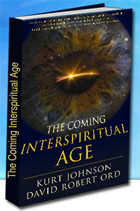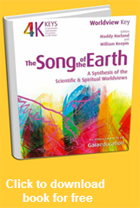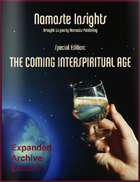By Kurt Johnson & David Robert Ord
Namaste Publishing, 2012
First, are you familiar with this book’s publisher, Namaste? Based from Vancouver, British Columbia, Canada, the publishing house keeps a small, select roster, releasing 2-3 titles annually. They also keep a giant in the building. It was Namaste, via founder Constance Kellough, who brought Eckhart Tolle to the world in 1997 with The Power of Now. That title went on to sell six million copies in 33 languages. In 2008, Oprah Winfrey hosted Tolle for a 10-episode television series viewed by 35 million. Tolle has followed The Power of Now with six additional books and related products. He remains one of the most sought after spiritual teachers in the world, sharing company (and occasional appearances) with the Dalai Lama.
So, if you are Namaste Publishing and you want to go big on a title (and by the countless blurbs in several of the book’s front pages, and on the back jacket, it seems they do) what do you got? Where is the monster hook? With The Coming Interspiritual Age (TCIA), Namaste has done it. Here please find: Tolle-level grandeur. They’ve given us a brilliant 14 billion-year planetary (occasionally interplanetary) ride captained by authors Johnson and Ord. Both are scholars with professional religious experience (Ord is also on staff at Namaste as editorial director). At over 400 pages, TCIA is a profound study of human spirituality that is at once accessible, brisk, rigorous, and exhilarating.
In beginning such a review, my spell check stayed unhappy with both the words “interspiritual” and “interspirituality.” I took this as a sign with where to start talking. The authors explain interspiritual as the idea that “the entire religious experience of our species has [in fact] been a single experience unfolding through many lines and branches, together empowering our species for higher evolution.” Interspiritual was coined in 1999 by Roman Catholic lay monk Brother Wayne Teasdale (1945-2004). Teasdale was a pioneer of interfaith theory and considered an expert in the area by his life’s end. Here is a signature Teasdale quote referenced throughout TCIA:
The real religion of humankind can be said to be spirituality itself, because mystical spirituality is the origin of all the world religions. If this is so, we might also say that interspirituality—the sharing of ultimate experiences across traditions—is the religion of the third millennium. Interspirituality is the foundation that can prepare the way for a planet-wide enlightened culture, and a continuing community among the religions that is substantial, vital, and creative. (The Mystic Heart by Wayne Teasdale, New World Library Press, 1999).
The Coming Interspiritual Age has grand ambitions. The book is up for re-framing Earth history, holding the tension between science and religion, and newly explaining how 100 billion or so of us have ever lived, want to more fully live, and may, in fact, soon be able to live. This is done not by reviewing interfaith discourse(s), but through scientific andreligious epochal exploration.
The authors understand that the influence of the origins of human identity are profound. They address this issue early and often – how might we process that much of the world now, not to mention across time, has used religion (not science) to explain human identity? They shift to recent times to review forces of scientific discovery, pointing toward patternsand processes for answers of what a coming age should entail. In one case, they note major world religions are now increasingly comfortable with evolution as an explanation of human origins – that there is a traceable pattern of acceptance in Christianity, Judaism, and Islam with between 30 and 40 percent of adherents accepting the theory. There is a continued interest across similar identity questions leading to what process can be deduced from this pattern? How can such a process be better understood, and modeled?
Author Kurt Johnson, Ph.D., has a professional background that includes time as an Anglican monk. He has completed doctoral studies in evolutionary biology and ecology and now works primarily in comparative religious studies. He resides in Brooklyn, New York.
TCIA examines, across many chapters representing the bulk of the book, the Magic-Mythic age, into the rise of the God-Kings, onto the Renaissance and Enlightenment. The book arrives at our present time, ripe with scientific knowledge, but in terms of spirituality, comfortable and even hungry for – wait for it – trappings of the Magic-Mythic age again. The authors point to the hubbub of the Mayan December 21, 2012 date as an indicator of the public’s thirst for prophecy and fulfillment. Further, they note the unsurpassed popularity of morally conscious fantasies such as Star Wars and the Harry Potter series. It is a wonder that our scientific knowledge doesn’t appear to have the same sort of narrative satisfaction as these spiritually-minded films.
“Seldom do terrorists act in the name of consciousness religions,” write Johnson and Ord. The book projects history to arrive where religious identification is ultimately immaterial. The authors explain that we are moving, albeit slowly, from “hot religions” to “cool.” This is to say that, across the globe, dooming one another in the name of “our one true god/no-you-are-going-to-Hell” is on the decrease. A conscionable life-givingness, a generosity, an embodied compassion, all are becoming persuasive and soon, pervasive. Territory formerly occupied by religious creeds is falling to the unstoppability of a conscionable spirituality filled with deeds. That is to say that in the eyes of Johnson and Ord creeds are losing their level of influence. The more that such a spirituality be born – the more consciousness across our planet. The more consciousness, the more one-ness. This One-ness is our endgame according to the book. This is the great interspiritual hallmark meant to gird the Third Millenium.
It seems impossible to come to this book without one’s own personal background coloring the experience of the contents. For me, as one identified (if reservedly) as a Christian (I am a member in the Presbyterian Church USA), I was thrilled with this book’s desire for total redemption of and ultra-connection among all peoples. The emphasis on deeds over creeds makes great sense to me, and the book fleshes out early… it’s the institutions that provide the creeds. For example:
Almost everything wrong with the world is the result of the way the institutional space is misaligned or out of control. When was the last time your bank did you a favor? What was your opinion of the “no questions asked” multi-trillion dollar bailout of the financial industry? When you examine social structures anywhere in the world, the most obvious disconnect is between the needs and wants of the “I” and “We” that built the institutional space, and the way the institutional space behaves toward us.
(Such a passage is an example of the book’s ability to humanely editorialize more philosophical points.) But to continue the idea of Christianity and TCIA, was Jesus an advocate of interspirituality? I believe so. I see Christ pointing – always – to this experience and truth: God is Love. Love for You. Love for All. I see the early church and apostles carrying this out, while wrestling with how to keep the institutional Judaic laws (creeds). It was an emerging conversation then, messy and too often culturally influenced. Meanwhile, we do not see from Christ the exclusion of other faiths and traditions. If you could be with him, you could Be. With. Him. It was a deeds experience. The only strong teaching we have from Jesus on religion was his calling out of the Judaic Scribes and Pharisees – their abuse of the power they held in their positions. Meanwhile, a generation or more later, tasked with capturing his version of Christ’s life, John, that most mystic of Christ’s disciples, up in years, opens his gospel account with, to my mind, an interspiritual account of reality. I hope you are familiar with his words beginning John 1, culminating with the declaration the light shines in the darkness and the darkness has not overcome it.
I commend The Coming Interspiritual Age to those with the following interests:
Anyone with a love of futurism, no matter what religious disposition. Anthropology majors and those (including me) who wish they’d been. Historians. Those who enjoy the occasionally-expressed science-minded side of Fr. Richard Rohr (who is a featured blurb on the back cover), Joseph Campbell fans (which makes me think of Bill Moyers, who also deserves this company). Stephen Hawking fans with an interest in religion. Readers of Brian McLaren’s most “meta” works will be delighted. If you are familiar with any of the community Tami Simon and Sounds True keeps (thinking of Mirabai Starr first, and there are others), this is a great extension (and gentle amalgamation) of the values of that group. Also, Krista Tippett, and her similarly bold cadre of thinkers, dreamers, and doers.
Order The Coming Interspiritual Age here and other fine e-tailers and retailers.





